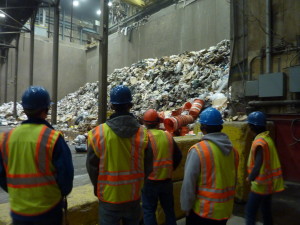 CFACT students from the University of Minnesota had the exciting opportunity to get a behind the scenes tour of the Hennepin Energy Recovery Center. This waste to energy facility, located in Minneapolis Minnesota, is an innovative way to dispose of large amounts of waste and produce energy.
CFACT students from the University of Minnesota had the exciting opportunity to get a behind the scenes tour of the Hennepin Energy Recovery Center. This waste to energy facility, located in Minneapolis Minnesota, is an innovative way to dispose of large amounts of waste and produce energy.
 The Hennepin Energy Recovery Center, or HERC for short, greatly reduces the amount of trash and waste that would otherwise be sent to Minnesota landfills. Every day the HERC burns 1212 tons of waste, which is nothing to turn your nose up at. That waste adds up, and each year the HERC burns enough trash to cover fifteen football fields with a blanket of garbage 15 feet thick. The HERC also has pollution control systems to mitigate any emissions that would otherwise get in the air.
The Hennepin Energy Recovery Center, or HERC for short, greatly reduces the amount of trash and waste that would otherwise be sent to Minnesota landfills. Every day the HERC burns 1212 tons of waste, which is nothing to turn your nose up at. That waste adds up, and each year the HERC burns enough trash to cover fifteen football fields with a blanket of garbage 15 feet thick. The HERC also has pollution control systems to mitigate any emissions that would otherwise get in the air.
Beyond learning about impact the HERC has on reducing pollution in the Twin Cities, CFACT students also got go behind the scenes and see the inner workings of the plant. They were able to see the (very smelly) pit where trash trucks empty their loads of refuse and the massive claw that loads the waste into the furnace. The students also got to see the furnace in action as it burned huge amounts of trash.
 Innovation is one of the key tenants of CFACT, and the HERC shows how innovation can help the environment. We can now cleanly burn trash and convert it into energy, instead to sending massive amount of trash to rot in a landfill. Unfortunately some people oppose burning trash. When they think of waste to energy centers they conjure up massive, obsolete incinerators that belch pollution into the air. This is not what the HERC does, and these people, by opposing waste to energy centers, may be doing more harm to the environment than good.
Innovation is one of the key tenants of CFACT, and the HERC shows how innovation can help the environment. We can now cleanly burn trash and convert it into energy, instead to sending massive amount of trash to rot in a landfill. Unfortunately some people oppose burning trash. When they think of waste to energy centers they conjure up massive, obsolete incinerators that belch pollution into the air. This is not what the HERC does, and these people, by opposing waste to energy centers, may be doing more harm to the environment than good.



